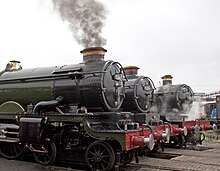Chimney (locomotive)


Thechimney(smokestackorstackinAmericanandCanadian English) is the part of asteam locomotivethrough whichsmokeleaves theboiler.As well,steam locomotive exhaust systemstypically vent cylinder steam exhaust through the chimney, to enhance the draught through the boiler. Chimneys are designed to carry the exhauststeamand smoke clear of the driver's line of sight while remaining short enough to clear overhead structures. Some chimneys included apparatus to suppress the dispersal of sparks.
Function[edit]
The chimney was usually located at the leading end of the locomotive, above thesmokebox,furthest away from the driver's cab andfirebox.The earliest locomotive chimneys were typically tall enough to sustain temperature-induced density difference draught through afire-tube boilerwhile the locomotive was stationary. However, following the example ofRichard Trevithick's first locomotive in 1804, most designs diverted steam cylinder exhaust upward through the chimney to create a vacuum in the smokebox, thereby accelerating airflow through the firebox while the locomotive was in motion.[1]
High chimneys on locomotives with lowfootplateshad the additional advantage of keeping smoke and condensing steam above the engine driver's field of vision.Gradelimitations on railways through hilly terrain required tunnels and overhead bridges, which imposed aloading gaugelimiting the height of chimneys. Increasing the velocity of steam exhaust tended to both accelerate airflow through the firebox and lift the smoke higher above the top of the chimney. By the 1830s, steam exhaust was directed through a contracted nozzle called ablastpipe,so as to achieve the desired velocity through the chimney. Pressure drop through the blastpipe nozzle was subtracted from the boiler pressure available to the steam pistons.Robert Stephensonestimated some locomotives lost half their power through blastpipeback pressure.[2]
As developments in boiler design led to improvements inheat transferefficiency, blast pipe diameters increased to reduce back pressure, and blastpipes became shorter, discharging below the chimney rather than within it.Ross Winansplaced conical "petticoat pipes" above blastpipes about 1848[2]to form the convergent portion of aventuri tube,with the chimney forming the divergent portion.[3]Improved understanding ofcompressible flowencouraged more sophisticated blastpipe and venturi chimney designs.George Jackson Churchward,working atSwindonon theGreat Western Railway,formulated a simple equation for calculating the ideal dimensions for chimneys, which worked well for the early years of the 20th century, but become outdated as engine power increased.André ChapeloninFrancecontinued to work on chimney dimensions and studied them, in conjunction with blastpipe dimensions, as a completeexhaust system.That led to his famousKylchapsystem, which was fitted to many classes of locomotives worldwide. Even after the use of commercial steam locomotives in most of the developed world came to an end, theArgentineanengineerLivio Dante Portacontinued to work on developing steam locomotive exhaust systems, including refining equations to give better chimney dimensions.
Spark arrestors[edit]
Locomotives built inGreat Britain,wherecokewas the most common fuel, often used chimneys ofcast iron,because they lasted longer than chimneys fabricated fromsheet metal.EarlyNorth Americanlocomotives often used wood fuel, which resulted in large numbers of glowing embers being carried through the boiler from thefireboxand blasted out of the chimney by the high-velocity exhaust steam.[4]To reduce the number of fires started by escaped embers,spark arrestorsbecame a common feature of wood-burning locomotive chimneys. The difficulty of casting complex spark arrestors encouraged fabrication of sheet metal chimneys for wood-burning locomotives.[5]

Early spark arrestors were simply iron wirescreensinstalled within the stack. However, the screen reduced the rate at which smoke and steam could escape from the boiler. As well, embers caught by the screen further reduced available space for the passage of steam, and smoke and heat generated by the burning embers rapidly melted the wire screen. Chimney top diameters were enlarged to increase screen surface area and reduce smoke velocity through the screen so that embers could fall away from the screen into collection hoppers. In response to an 1857 patent infringement claim,Baldwin Locomotive Workscompiled a diagram illustrating 57 different spark arresting chimney designs.[4]
The most popular design was a bonnet chimney. The bonnet was afunnel-shaped sheet metal cone fitted over a conventional cylindrical chimney. The lower, small-diameter portion of the cone served as a collection hopper for falling embers. The upper portion of the cone concealed an inner cone at the top of the cylindrical chimney, which deflected escaping steam, smoke and embers outward against the inner walls of the outer cone. The heavier embers were expected to fall into the hopper below, while the lighter steam and smoke passed upward through a wire screen over the upper, large-diameter end of the outer cone. Deflection of the embers typically limited the life of the screen to three or four weeks. Some of those chimneys included provision for dropping collected embers into a portion of the smokebox called the subtreasury. Sophisticated designs, such as the Radley & Hunter, incorporated various centrifugal separation baffles into the bonnet. As coal replaced wood fuel, the bonnet was reduced into a simple diamond chimney, housing the inner deflecting cone, with or without the upper wire screen, but without any collection hopper.[4]
Aesthetics[edit]
The bonnet chimney became one of the most distinctive features 19th-century American locomotives. That, along with a large rectangular oilheadlamp,gave them an air of grandeur.[4]Many designers or railway companies had their own distinctive style, such as theWilliam Adams'"Stovepipe" chimney on the 19th centuryLondon and South Western Railway,or the copper-capped chimneys on theGreat Western Railway.
As locomotive boilers grew larger, the space available for chimneys was reduced, because they still had to fit within the sameloading gauge.That reduced the effectiveness of the chimney in keeping the exhaust gases away from the driver's line of sight and, as a result, locomotives had to be fitted with devices such assmoke deflectors.
Notes[edit]
Sources[edit]
- Phillips, Lance (1965).Yonder Comes the Train.Cranberry, New Jersey: A.S. Barnes and Company.ISBN0-498-06303-8.
- Sears, Francis Weston; Zemansky, Mark W. (1964).University Physics(Third ed.). Reading, Massachusetts: Addison-Wesley Publishing Company.
- White, John H. Jr. (1979).A History of the American Locomotive(Dover ed.). New York: Dover Publications.ISBN0-486-23818-0.
